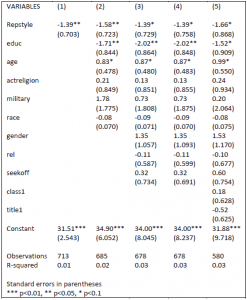Bradley Masters
Main Text
John Kingdon, in his famous book, Congressman’s Voting Decisions, said, “Because congressmen rely most heavily on colleagues within the house and on constituents for guidance as they vote, other actors in the system such as lobbyists and administration policy makers tend to work through these two gatekeeper sources” (Kingdon 1989, My work with this ORCA grant has helped to shed light on an important distinction that is not explored by Kingdon: some congressman will rely more heavily on colleagues within the house and some will rely more heavily on constituents.
I became very interested in the decision-making process of elected officials. How do they obtain relevant information and on which information sources do they most often rely? In order to study this, I used as my independent variable a measure of representational style known as the delegate-trustee model. The delegate-trustee model of representational theory emphasizes two polar notions of how representation should work. For delegates, elected officials should do what the constituents want even if it conflicts with what the elected official thinks is right. For trustees, elected officials should do what they think is right even if it conflicts with what the constituents want. I hypothesized that delegate-type elected officials would likely spend more time with their constituents than trustees because it is important for them to get an understanding of how their constituents are situated on the various issues. Thus, when Kingdon says that congressman rely most heavily on colleagues and constituents, we may now have a clearer understanding of who relies on which type of information more.
To obtain our results, we surveyed an exhaustive list of every elected official in the state of Utah: city council, mayors, county council, and state representatives and senators. We also included members of planning commissions in the cities and towns as a point of comparison, even though they are not elected. The survey was sent to 2,500 individuals and had a total of 818 full responses, for a response rate of about 33%, which is much larger than we had initially expected. The survey was in the field for one month, throughout which we administered 8 mixed mode contacts: emails and postal mail.
In accordance with my hypothesis, I found that representational style does predict the amount of time elected officials spend with their constituents, with delegate-type officials spending more time than trustee-type officials. Additionally, we found it interesting that the majority of elected officials in Utah are trustees. This was unusual because it is very likely that the constituents feel quite different than this, given the highly conservative population and general distrust with establishment politicians. This could lead to future studies concerning the disparity between representational style preferences between voters and elected officials.
This research was presented at the Utah League of Cities and Town’s semi-annual conference for elected officials in the state of Utah. It was well-received and we were asked to continue this survey of elected officials every year.
Below are some key findings:

Model 5 includes the various control variables, yet still shows that there is a negative relationship between being a trustee and spending more time with constituents. Thus, delegates do in fact spend more time with constituents than trustees.
